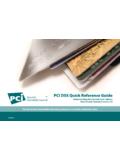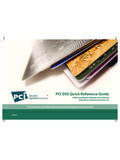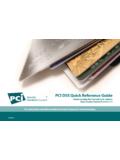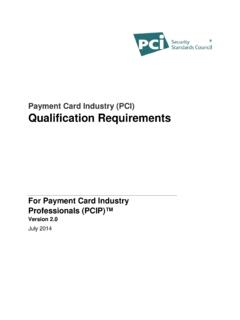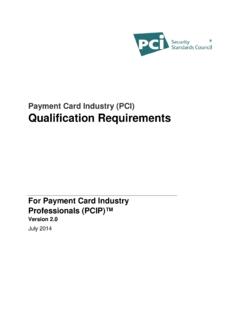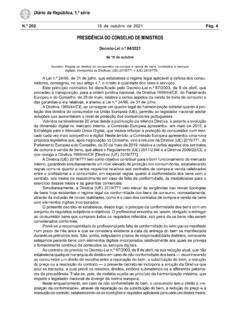Transcription of Best Practices for Securing E-commerce
1 Standard: PCI Data Security Standard (PCI DSS) Date: April 2017 Authors: best Practices for Securing E-commerce Special Interest Group PCI Security Standards Council Information Supplement: best Practices for Securing E-commerce Information Supplement best Practices for Securing E-commerce April 2017 The intent of this document is to provide supplemental information. Information provided here does not replace or supersede requirements in any PCI SSC Standard. ii Document Changes Date Document Version Description Pages January 2013 Initial release All January 2017 Expanded and revised content based upon the Securing E-commerce Special Interest Group Various April 2017 Corrected entries in table, Section typographical and grammatical errors Various Information Supplement best Practices for Securing E-commerce April 2017 The intent of this document is to provide supplemental information. Information provided here does not replace or supersede requirements in any PCI SSC Standard.
2 Iii Table of Contents Document Changes .. ii 1 Introduction .. 5 Background .. 5 Intended Audience .. 7 Terminology .. 7 2 Understanding E-commerce implementations .. 8 Shared-Management E-commerce URL Redirects .. 8 The iFrame .. 10 The Direct Post Method (DPM) .. 13 JavaScript Form .. 15 The Application Programming Interface (API) .. 17 Wholly Outsourced E-commerce Solutions .. 19 Advantages and Disadvantages of E-commerce Methods .. 20 PCI DSS Validation Requirements .. 21 The Intersection between E-commerce and Other Payment Channels .. 22 E-commerce Scoping Considerations .. 23 Additional Considerations .. 26 3 Public Key Certificate Selection .. 34 Brief History on SSL and TLS .. 34 Selecting the Certification Authority .. 34 Selecting the Appropriate Type of Public Key Certificates .. 35 Tools for Monitoring and Managing E-commerce Implementations .. 36 4 Encryption and Digital Certificates.
3 37 Certificate Types (DV, OV, EV) and Associated Risks .. 37 TLS Configurations .. 39 Merchant Questions on Certificate Types and TLS Migration Options .. 40 5 Guidelines to Determine the Security of E-commerce Solutions .. 44 E-commerce Solution Validation .. 44 Validation Documentation .. 45 PCI DSS Requirement Ownership .. 46 6 Case Studies for E-commerce Solutions .. 47 Case Study One: Fully Outsourced Redirect .. 47 Case Study Two: Fully Outsourced iFrame .. 49 Case Study Three: Partially Outsourced (JavaScript-Generated Form) .. 51 Case Study Four: Merchant Managed (API) .. 53 7 best Practices .. 55 Know the Location of all Your Cardholder Data .. 55 If You Don t Need It, Don t Store It .. 55 Evaluate Risks Associated with the Selected E-commerce Technology .. 55 Service Provider Remote Access to Merchant Environment .. 56 ASV Scanning of E-commerce Environments .. 56 Penetration Testing of E-commerce Environments.
4 56 Information Supplement best Practices for Securing E-commerce April 2017 The intent of this document is to provide supplemental information. Information provided here does not replace or supersede requirements in any PCI SSC Standard. iv best Practices for Securing E-commerce .. 57 Implement Security Training for all Staff .. 58 Other Recommendations .. 58 best Practices for Consumer Awareness .. 58 Resources .. 59 Acknowledgments .. 62 About the PCI Security Standards Council .. 64 Information Supplement best Practices for Securing E-commerce April 2017 The intent of this document is to provide supplemental information. Information provided here does not replace or supersede requirements in any PCI SSC Standard. 5 1 Introduction Electronic commerce , commonly known as E-commerce , is the use of the Internet to facilitate transactions for the sale and payment of goods and services. E-commerce is a card-not-present (CNP) payment channel and may include: E-commerce websites accessible from any web-browser, including mobile-device friendly versions accessible via the browser on smart phones, tablets, and other consumer mobile devices App versions of your E-commerce website, , apps downloadable to the consumer s mobile device or saving of the URL as an application icon on a mobile device that has online payment functionality (consumer mobile payments) The objective of this information supplement is to update and replace the PCI DSS E-commerce Guidelines published in 2013.
5 This information supplement offers additional guidance to that provided in PCI DSS and is written as general best Practices for Securing E-commerce implementations. All references in this document are for PCI DSS Version The guidance focuses on the following: Different E-commerce methods, including the risks and benefits associated with each implementation as well as the merchant s responsibilities The selection of public key certificates and certificate authorities appropriate for a merchant s environment Questions a merchant should ask its service providers (certificate authorities, E-commerce solution providers, etc.) General recommendations for merchants Background An E-commerce solution comprises the software, hardware, processes, services, and methodology that enable and support these transactions. Merchants choosing to sell their goods and services online have a number of methods to consider, for example: Merchants may develop their own E-commerce payment software, use a third-party developed solution, or use a combination of both.
6 Merchants may use a variety of technologies to implement E-commerce functionality, including payment-processing applications, application-programming interfaces (APIs), Inline Frames (iFrames), or payment pages hosted by a third party. Merchants may also choose to maintain different levels of control and responsibility for managing the supporting information technology infrastructure. For example, a merchant may choose to manage all networks and servers in-house, outsource management of all systems and infrastructure to hosting Information Supplement best Practices for Securing E-commerce April 2017 The intent of this document is to provide supplemental information. Information provided here does not replace or supersede requirements in any PCI SSC Standard. 6 providers and/or E-commerce payment processors, or manage some components in house while outsourcing other components to third parties. Merchants may also decide to engage a third party to perform services that support their E-commerce solution.
7 The service provider or the services may be considered in scope for a merchant s PCI DSS compliance if the security of the solution is impacted by this service and the service provider has not performed its own assessment. For more information, see the section on Use of Third-Party Service Providers/Outsourcing in the PCI DSS. Examples of common E-commerce support services that may affect cardholder data security include: a) Software development on behalf of the merchant b) Hosted website, either fully or partially managed by the solution provider c) Hosted data center/network/physical systems in support of a website d) Shopping-cart software (including software that hands off transactions or customer information to other systems) e) Order-management software such as chargebacks, returns, etc. that may have access to cardholder data f) Other hosting options (offline data storage, backups, etc.) depending on whether the data is encrypted and whether the service provider has access to the decryption keys g) Merchant plug-ins to support payment brand and issuer authentication mechanisms h) Managed services, including WAF or log-management services i) Any service that transmits cardholder data (CHD) or handles this data in some other fashion on behalf of the merchant services that have access to the checkout or payment-processing flow, including those without a need to access cardholder data, third-party fraud analysis, or analytics tools No matter which option a merchant may choose, there are several key considerations to keep in mind regarding the security of cardholder data, including: No option completely removes a merchant s PCI DSS responsibilities.
8 Regardless of the extent of outsourcing to third parties, the merchant retains responsibility for ensuring that payment card data is protected. A merchant is responsible for performing due diligence to ensure the service provider is protecting the CHD shared with it in accordance with PCI DSS. It is the acquirer or payment card brand, that determines whether a merchant must conduct an onsite assessment or is eligible for a Self-Assessment Questionnaire (SAQ). Third-party relationships and the PCI DSS responsibilities of the merchant and each third party should be clearly documented in a contract or service-level agreement to ensure that each party understands and implements the appropriate PCI DSS controls. More information on these relationships can be found in the Third-Party Security Assurance Information Supplement on the PCI SSC website. Information Supplement best Practices for Securing E-commerce April 2017 The intent of this document is to provide supplemental information.
9 Information provided here does not replace or supersede requirements in any PCI SSC Standard. 7 It is recommended the merchant monitor connections and redirections between the merchant and the third party since the connections can be compromised. The merchant should ensure no changes have occurred and that the integrity of the E-commerce solution is maintained. It is recommended that E-commerce payment applications, such as shopping carts, be validated according to PA-DSS, and confirmed to be included on PCI SSC s list of Validated Payment Applications. For in-house developed E-commerce applications, PA-DSS should be used as a best practice during development. Intended Audience This guidance is intended for merchants who use or are considering use of payments through E-commerce technologies in their cardholder data environment (CDE) as well as third-party service providers that provide E-commerce services, E-commerce products, or hosting/cloud services for E-commerce merchants.
10 This document may also be of value for assessors reviewing E-commerce environments as part of a PCI DSS assessment. The guidance is applicable to merchants of all sizes, budgets, and industries. This document will be most useful to those merchants that have a solid understanding of their current E-commerce solution and environment. For small-to-medium sized merchants who do not know their E-commerce solution or environment, the recommendation is to review the PCI SSC Payment Protection for Small Merchants1 first and then review the guidance in this document. This document is not intended as an endorsement for any specific technologies, products, or services but rather as recognition that these technologies exist and may influence the security of payment card data. Terminology The following term is used throughout this document: Payment Service Provider (PSP): A PSP offers a service that directly facilitates E-commerce transactions online via its relationship with acquiring member banks of payment card brands.

